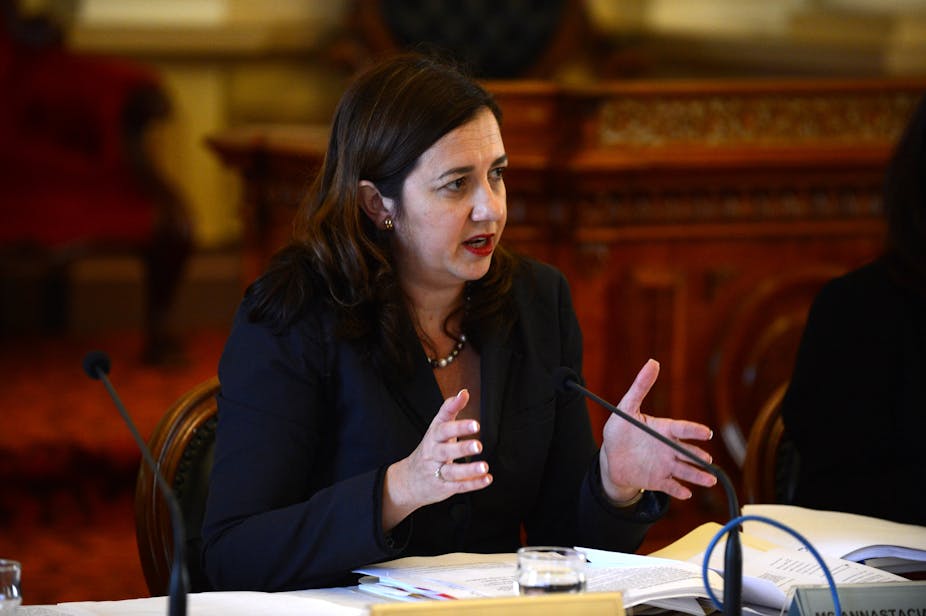The rule of thumb in Australian politics has been that voters are reluctant to throw out governments after a single term. And if they do, it’s during a major crisis.
Perhaps that’s a measure of Australians’ inherent conservatism. After all, Australia has had just seven changes of federal government since the end of the Second World War, compared to more than 60 in Italy. Or maybe it’s just Australia’s egalitarian sense of a fair go – a belief that everyone deserves a second chance no matter how inglorious the first.
But last weekend’s Victorian state election result, and rapid public opinion gains for first-term oppositions elsewhere, may be turning that maxim on its head.
Victorian Labor’s Daniel Andrews scored a modest 2% swing on the votes counted so far, but it was enough to dislodge the Napthine Coalition government after just four years in office. The last time Victoria dumped a first-term government was in 1955 when Liberal Henry Bolte defeated Labor’s John Cain snr soon after the great Labor split.
The case of New South Wales is different. While Labor leader John Robertson has shaved up to 10% off the government’s vote, Labor still trails the Coalition by 12 points after preferences. Given Mike Baird also remains well ahead of Robertson as preferred premier, the chances of NSW voters ditching the Coalition after a single term next March are remote.
Then there’s the federal arena. On current polling, Labor is eight points clear of the Coalition. This also suggests Australian voters are inclined to make the Abbott government the first one-term wonder since James Scullin’s Labor Party was dumped in 1931 in the depths of the Great Depression. Senior Coalition MPs will be relieved this parliamentary term has two more years to run.
The scenario in Queensland is different again. With only slightly more than one in four electors supporting Labor in 2012, Queensland Labor was reduced to just seven seats in an 89-seat chamber – the party’s worst result since in 1891. But Labor’s recovery under leader Annastacia Palaszczuk - deep within what is arguably Australia’s most conservative and masculine political culture – is perhaps the most staggering turnaround of all.
After a year in opposition, Labor’s vote had barely improved. By early this year, Labor had closed the gap to a few points. Last weekend, a ReachTEL poll echoed two other recent surveys that placed Queensland Labor level with – or even slightly ahead of – the LNP Newman government.
On these figures, Queensland is close to following Victoria in dumping a first-term government sometime early next year. If the LNP does fall, it will be the first majority government to lose after a single term in Queensland since the conservative Moore government in 1932 – again because of the Great Depression.
Identifying exactly why voters are growing so impatient with governments, and far more quickly, is not so easy. There are some obvious and very specific factors peculiar to the Commonwealth and to each state. Perceptions of broken promises and an exceedingly tough budget have hampered Tony Abbott, just as a chaotic Victorian parliament and divided Liberal Party damaged Denis Napthine.

Liberal MPs embroiled in ICAC hearings have reined in the New South Wales Coalition, just as economic austerities, rising unemployment and clashes with powerful pressure groups (such as the legal profession) have damaged Queensland’s Campbell Newman.
But rapid opposition recovery is not always about what governments have or have not done. Oppositions, especially those comprehensively rejected by voters just three or four years before, must work proactively to re-cultivate support. Votes so early in electoral cycles rarely fall into opposition laps; support must be chiselled off governments that are usually far better resourced in public relations.
But the Victorian and Queensland cases offer the clearest lessons in how an opposition can win back voters. Incoming Victorian premier Daniel Andrews and Queensland Labor leader Annastacia Palaszczuk are at pains to emphasise the value of low-key, low-cost grassroots campaigning to reconnect with the very communities that so recently turned their backs. In spending hours doorknocking rather than dollars on advertising, voters see the human side of the political underdog.
As Palaszczuk suggested on Tuesday at the Queensland Media Club, this has been especially critical in Queensland where lifelong Labor voters deserted the party in droves in 2012 over the Bligh government’s sale of state assets. The last two-and-half years have been a journey, Palaszczuk said, “back to basics”.
She added that numerous town hall meetings in far-flung parts of the state have allowed her to fulfil a six-point plan: to rebuild the party, reconnect with voters, restore trust, return to core values, keep the government accountable, and develop alternative policies.
Just how successfully Palaszczuk has met each of these objectives is yet to be determined, but the 11-point recovery in Labor’s primary vote in Queensland since 2012 suggests the reconnection has worked on some level.
Queensland Labor is still at long odds to win the coming state election due within months. But if it does dislodge another first-term government, we will have entered a new era of voter behaviour that will send a chill through governments everywhere.

